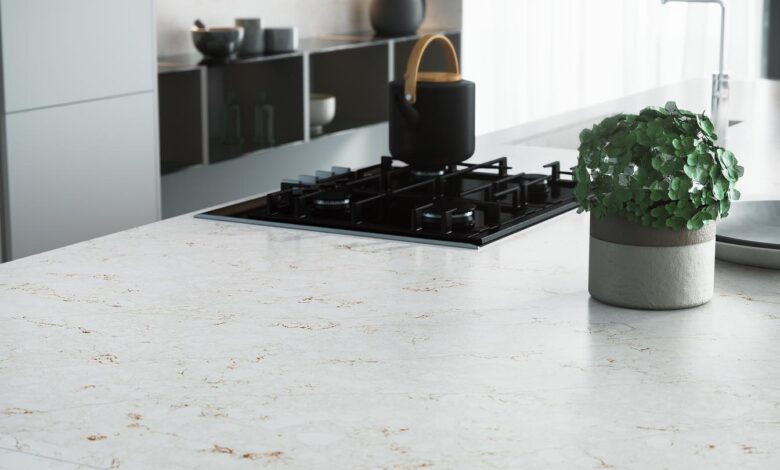The Environmental Impact of Quartzite Worktops: A Sustainable Choice?

Introduction
In an era where sustainability has become a critical consideration for homeowners, making environmentally conscious choices is more important than ever. The kitchen, often the heart of the home, is a significant area where these choices manifest. One such choice involves selecting materials for kitchen worktops. Quartzite, a natural stone known for its beauty and durability, has emerged as a sustainable option for kitchen worktops. This article delves into the environmental benefits of quartzite worktops and explains why they are considered a sustainable choice.
Natural Stone and Sustainability
Renewable Resource
Quartzite is a naturally occurring metamorphic rock that originates from sandstone. Through a natural process involving high pressure and temperature, sandstone is transformed into quartzite, resulting in a highly durable stone. The fact that quartzite is a natural stone quarried from the earth makes it a renewable resource. Unlike synthetic materials that require extensive industrial processes and raw materials, quartzite is available directly from nature. This direct availability significantly reduces the need for additional resources and energy, making quartzite an environmentally friendly choice from the start.
Longevity
One of the standout features of quartzite is its exceptional durability. This natural stone is known for its hardness and resistance to wear and tear, making it an ideal material for kitchen worktops. The longevity of quartzite worktops means they last significantly longer than many other materials. This extended lifespan reduces the need for frequent replacements, which in turn minimizes waste and conserves resources. In contrast, materials that require more frequent replacement contribute to environmental degradation through continuous resource extraction and waste generation.
Environmental Benefits of Quartzite Worktops
Low Emissions
The production of quartzite worktops involves significantly lower emissions compared to engineered stones. Engineered stones often require synthetic resins and other chemical components, which result in higher emissions during manufacturing. In contrast, the process of quarrying and finishing quartzite involves fewer chemical processes, leading to lower overall emissions. This makes quartzite a more environmentally friendly option for homeowners looking to reduce their carbon footprint.
Minimal Processing
Another environmental benefit of quartzite is the minimal processing it requires. Once quarried, quartzite needs only to be cut and polished before it is ready for installation. This minimal processing reduces the energy consumption and carbon footprint associated with its production. In comparison, engineered stones and other synthetic materials require extensive processing, which involves significant energy use and environmental impact.
Recyclable
At the end of its life, quartzite offers the advantage of recyclability. Unlike many synthetic materials that end up in landfills, quartzite can be recycled or repurposed. This recyclability further reduces its environmental impact, making it a sustainable choice even after its initial use as a worktop. The ability to recycle quartzite aligns with the principles of a circular economy, where materials are continuously reused and repurposed, minimizing waste and conserving resources.
Sustainable Practices in Quartzite Quarrying
Responsible Quarrying
Many companies involved in the quarrying of quartzite practice responsible quarrying methods. These methods are designed to minimize environmental disruption during the extraction process. Responsible quarrying involves strategies such as minimizing the area of land disturbed, restoring quarry sites after extraction, and implementing measures to protect local ecosystems. By adhering to these practices, companies ensure that the environmental impact of quartzite quarrying is kept to a minimum.
Local Sourcing
Choosing locally sourced quartzite can further enhance its sustainability. Local sourcing reduces the environmental impact associated with transportation. Transporting materials over long distances involves significant fuel consumption and emissions, contributing to environmental degradation. By opting for locally sourced quartzite, homeowners can support local economies while also reducing the carbon footprint associated with transportation.
Maintaining the Sustainability of Your Quartzite Worktop
Proper Sealing
To maintain the sustainability and longevity of a quartzite worktop, proper sealing is essential. Regular sealing helps protect the stone from stains and damage, ensuring it remains in good condition for a longer period. By extending the life of the worktop, homeowners can avoid the need for early replacements, thereby conserving resources and reducing waste.
Eco-Friendly Cleaners
Using eco-friendly cleaning products is another way to maintain the sustainability of a quartzite worktop. Many conventional cleaning products contain harsh chemicals that can be harmful to the environment. Eco-friendly cleaners, on the other hand, are formulated to be safe for both the environment and human health. By choosing these products, homeowners can keep their quartzite worktops clean without contributing to environmental pollution.
Comparing Quartzite to Other Worktop Materials
Engineered Stone
Engineered stones, such as quartz, are often marketed for their durability and variety of designs. However, these stones contain synthetic resins and other additives that increase their environmental impact. The production process for engineered stones involves higher energy consumption and emissions compared to natural stones like quartzite. While engineered stones offer certain aesthetic advantages, they fall short in terms of sustainability.
Laminate
Laminate worktops are a popular choice due to their affordability and wide range of designs. However, they have a shorter lifespan compared to quartzite and are less environmentally friendly. Laminate worktops often end up in landfills after a few years of use, contributing to environmental waste. Additionally, the production of laminate involves the use of synthetic materials and adhesives, which have a higher environmental impact.
Wood
Wood worktops are another renewable option, but they require significant maintenance and may not last as long as quartzite. Wood is susceptible to scratches, stains, and damage from moisture, necessitating regular maintenance and eventual replacement. While wood is a renewable resource, the frequent need for replacements can offset its environmental benefits. In contrast, quartzite offers superior durability with minimal maintenance requirements, making it a more sustainable choice in the long run.
Conclusion
Quartzite worktops represent a sustainable choice for environmentally conscious homeowners. The natural stone’s durability, low emissions, minimal processing, and recyclability make it an excellent option for a green kitchen. Furthermore, responsible quarrying practices and local sourcing can enhance the sustainability of quartzite. By choosing quartzite, homeowners can enjoy a beautiful, long-lasting worktop while minimizing their environmental footprint. In a world where sustainability is increasingly important, quartzite worktops stand out as a responsible and eco-friendly choice for modern kitchens.
Publication collaboration has been facilitated through= jamesoliver.advertising@gmail.com



